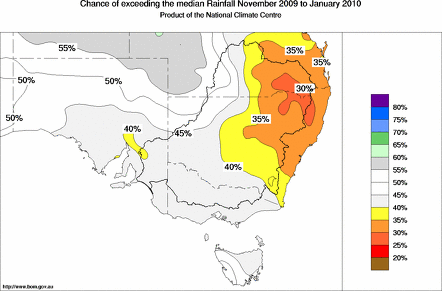| Southeastern Aust Seasonal Rainfall Outlook: probabilities for November 2009 to January 2010, issued 23rd October | |||||||||
Dry conditions favoured for most of NSWFor southeastern Australia, the outlook for rainfall for the late Spring to mid-summer period (November to January) favours drier than normal conditions for eastern NSW. The pattern of seasonal rainfall odds across southeastern Australia is a result of recent warm conditions in both the Pacific and Indian Oceans. The Pacific influence dominates the current outlook favouring drier conditions in southeast Australia. An El Niño event persists in the Pacific; these events often (but not always) result in drier than average conditions across the Murray-Darling Basin, southern Victoria, northern and eastern Tasmania and eastern South Australia at this time of year. 
The chances of exceeding the median rainfall for November to January are between 25 and 40% over eastern NSW (see map). This means that for every ten years with ocean patterns like the current, about six or seven years are expected to be drier than average over these regions, while about three or four years are wetter. Over South Australia, Victoria, Tasmania and the remainder of NSW the chances of exceeding the seasonal median are between 40% and 60%, meaning that above average falls are about as equally likely as below average falls in these regions. New: An expanded set of seasonal rainfall outlook maps and tables, including the probabilities of seasonal rainfall exceeding given totals (e.g. 200 mm), is available on the "Water and the Land" (WATL) part of the Bureau's website. Outlook confidence is related to how consistently the Pacific and Indian Oceans affect Australian rainfall. During the November to January period, history shows this effect to be moderately consistent over much of Tasmania, NSW, but generally weakly consistent elsewhere (see background information). An El Niño event persists across the Pacific Basin, with most leading climate models suggesting tropical ocean temperatures will remain above El Niño thresholds until at least early 2010. El Niño events are usually (but not always) associated with below normal rainfall in the second half of the year across large parts of southern and inland eastern Australia. The SOI is approximately −8 for the 30 days ending 20 October. For routine updates and comprehensive discussion on any developments please see the ENSO Wrap-Up. | |||||||||
Click on the map above for a larger version of the map. Use the reload/refresh button to ensure the latest forecast map is displayed. More detailed forecast maps, including the probabilities of seasonal rainfall exceeding given totals, can be found here. | |||||||||
|
More information on this outlook is available Monday to Friday from 9.00am to 5.00pm local time by contacting the Bureau's Climate Services sections in Queensland, NSW, SA, Victoria and Tasmania at the following numbers:
| |||||||||
THE NEXT ISSUE OF THE SEASONAL OUTLOOK IS EXPECTED BY 24th November 2009 Corresponding temperature outlook | |||||||||
Background Information
| |||||||||









